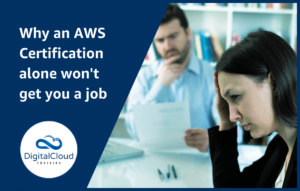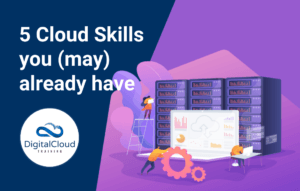Top 20 AWS Cloud Practitioner Interview Questions

It’s essential to be prepared for any tech interview and if you’re trying to land a cloud role you’d be well advised to understand some of the common AWS interview questions.
In this article, we’ll focus on AWS interview questions that may come up in interviews for junior roles in which a certification like the AWS Certified Cloud Practitioner is useful. Being prepared with some common AWS interview questions and answers can make a significant difference when you’re under pressure.
The AWS Certified Cloud Practitioner is an entry-level certification that provides individuals with an overall understanding of the AWS Cloud. It’s an excellent stepping stone for those new to cloud computing or AWS.
While it doesn’t dive deep into advanced technical tasks, the AWS Cloud Practitioner certification provides foundational knowledge beneficial for a variety of roles.
Jobs that an AWS Cloud Practitioner might undertake include sales and marketing of cloud services, project management, business analyst, cloud support associate, account manager, technical writing, and entry-level cloud operations.
If you’re preparing for an AWS Cloud Practitioner role, here are 20 of the most common AWS Cloud Practitioner interview questions to prepare you:
- What is AWS?
- Answer: AWS stands for Amazon Web Services. It’s a secure cloud services platform offering compute power, database storage, content delivery, and various other functionalities to help businesses scale and grow.
- What are the key benefits / advantages of cloud computing?
- Answer: According to AWS, the 6 advantages of cloud are:
- Trade capital expense for variable expense – Instead of having to invest heavily in data centers and servers before knowing how they’re going to be used, you can pay only when you consume computing resources, and pay only for how much you consume.
- Benefit from massive economies of scale – Because of the large number of customers aggregated in the cloud, providers such as AWS can achieve higher economies of scale which translates into lower costs.
- Stop guessing capacity – With cloud computing, you don’t have to guess how much capacity you will need. You can scale up or down to accommodate growth or changes without upfront huge expenses.
- Increase speed and agility – With cloud, vast amounts of computing resources can be provisioned in minutes. This gives businesses a lot of flexibility and taking the pressure off capacity planning.
- Stop spending money on running and maintaining data centers – Focus on projects that differentiate your business, not the infrastructure. Cloud computing lets you focus on your customers, rather than on the heavy lifting of racking, stacking, and powering servers.
- Go global in minutes – With the benefits of cloud, you can deploy your application in multiple regions around the world with just a few clicks. This means you can provide lower latency and a better experience for your customers at minimal cost.
- Answer: According to AWS, the 6 advantages of cloud are:
- Explain the difference between “scaling up” and “scaling out” in AWS.
- Answer: Scaling up (vertical scaling) means adding more power to your existing machine, while scaling out (horizontal scaling) implies adding more machines to your network.
- What is the AWS Well-Architected Framework?
- Answer: It’s a set of best practices and strategies for reviewing architectures and implementing designs that can scale over time.
- What are the pillars of the AWS Well-Architected Framework and why are they important?
- Answer: The AWS Well-Architected Framework consists of five pillars:
- Operational Excellence: Focuses on running and monitoring systems to deliver business value, and continually improving processes and procedures.
- Security: Emphasizes the importance of protecting information, systems, and assets while delivering business value through risk assessments and mitigation strategies.
- Reliability: Ensures that a workload performs its intended function correctly and consistently when it’s expected to.
- Performance Efficiency: Concentrates on using IT and computing resources efficiently.
- Cost Optimization: Focuses on avoiding unnecessary costs and getting the most value out of your AWS resources.
- Answer: The AWS Well-Architected Framework consists of five pillars:
- Define AWS IAM and its significance.
- Answer: AWS Identity and Access Management (IAM) allows users to control access to resources in AWS securely. It’s significant for managing users, roles, and permissions.
- Can you explain the concept of “Regions” and “Availability Zones” in AWS?
- Answer: In AWS, a “Region” is a physical location around the world where data centers are clustered. Each region consists of multiple, isolated, and physically separate “Availability Zones” within a geographic area. Availability Zones consist of one or more data centers that have redundant power, networking, and connectivity to form a highly reliable and fault-tolerant infrastructure.
- What is Auto Scaling?
- Answer: Auto Scaling is a feature of AWS which allows you to configure and automatically provision and spin-up new instances without the need for your intervention.
- What are the different types of cloud services?
- Answer: Generally, cloud services are categorized into three types: Infrastructure as a Service (IaaS), Platform as a Service (PaaS), and Software as a Service (SaaS).
- What is the Shared Responsibility Model in AWS?
- Answer: The AWS shared responsibility model is a cybersecurity framework that dictates which security controls are AWS’s responsibility and which are left for the user. While AWS is responsible for the security of the cloud (infrastructure, hardware, software, and facilities), customers are responsible for security in the cloud (customer data, apps, identity and access management, operating system patches and updates, etc.).
- Can you explain the different pricing models available in AWS?
- Answer: AWS offers several pricing models:
- Pay-as-you-go: This model allows you to pay only for the individual services you use and for only as long as you use them, without any long-term commitments.
- Save when you reserve: For certain services like Amazon EC2 and Amazon RDS, you can invest in reserved capacity. With Reserved Instances, you can save up to 75% over equivalent on-demand capacity.
- Less by using more: With services like Amazon S3 and AWS data transfer, the more you use, the less you pay per GB.
- Free tier: AWS offers a free tier for some services which is available to all new customers for 12 months following the AWS sign-up date. These free tier offers are only available to new AWS customers and are available for 12 months following your AWS sign-up date.
- Answer: AWS offers several pricing models:
- Could you elaborate on the support plans available on AWS?
- Answer: AWS offers four levels of support plans:
- Basic: Includes customer service and support for billing and tech issues.
- Developer: Designed for testing or development environments. It provides best-practice guidance, and troubleshooting help, with a 12-hour response time.
- Business: Suitable for production environments. It offers 24/7 access to Cloud Support Engineers, one-hour response time for urgent issues, and support for third-party software.
- Enterprise: Meant for businesses running mission-critical workloads. Provides 15-minute response times for critical issues, a dedicated Technical Account Manager (TAM), and support for launching new applications.
- Answer: AWS offers four levels of support plans:
- Can you identify common AWS services and their use cases?
- Answer:
- Amazon EC2: Provides scalable computing capacity in the AWS cloud, used for web server hosting, backend servers for applications and databases, batch processing, and large-scale gaming servers.
- Amazon S3: An object storage service, ideal for storing large amounts of unstructured data like multimedia files, backups, and archives.
- AWS Lambda: A serverless compute service, executing code in response to events, perfect for building scalable event-driven applications and automating processes and workflows.
- Amazon RDS: A managed relational database service for setup, operations, and scaling of relational databases in the cloud, used for managing database applications.
- Amazon VPC: Enables you to launch AWS resources into a virtual network that you’ve defined, ideal for managing logical network isolation and provisioning secure, private, and customizable networking environments.
- Answer:
- What is meant by “Elasticity” and “Scalability” in AWS?
- Answer: “Elasticity” refers to the ability of a system to automatically scale resources, both in and out, so that it can adjust to traffic to maintain predictable performance at the lowest possible cost. “Scalability” is the ability of the system to increase its capacity to handle higher loads, either through adding resources at the current setup or by adding additional configurations.
- In terms of security, how does AWS protect its customers’ data?
- Answer: AWS implements strong safeguards to protect customer privacy. All data is stored in highly secure AWS data centers. AWS manages dozens of compliance programs in its infrastructure, uses encryption for data in transit and at rest, and offers various tools for securing private networks, configuring access controls, and monitoring and logging activities.
- How does AWS contribute to environmental sustainability?
- Answer: AWS is committed to running its business in the most environmentally friendly way possible. It has numerous initiatives in energy efficiency, renewable energy, and sustainable water use. AWS data centers are designed to use 28% less energy than traditional data centers. Also, AWS has set a long-term goal to power its global infrastructure with 100% renewable energy.
- Can you explain the AWS Cloud Adoption Framework and its primary perspectives?
- Answer: The AWS Cloud Adoption Framework (CAF) provides guidance for developing an efficient and effective plan for cloud adoption. It breaks down the process into six perspectives:
- Business: Focuses on business goals and objectives to ensure cloud adoption aligns with business strategies.
- People: Addresses organizational structure and changes in roles and responsibilities.
- Governance: Covers risk and compliance profiles.
- Platform: Emphasizes architecture and infrastructure focus.
- Security: Ensures that the organization maintains security and compliance in the cloud.
- Operations: Aligns operational best practices across the environment. Each perspective provides a set of guiding principles that represent areas of focus during a cloud adoption phase.
- Answer: The AWS Cloud Adoption Framework (CAF) provides guidance for developing an efficient and effective plan for cloud adoption. It breaks down the process into six perspectives:
- What is the Principle of Least Privilege and why is it important in AWS?
- Answer: The Principle of Least Privilege (PoLP) means granting only the minimum permissions necessary to perform a function. In AWS, it ensures that users, applications, and services have only those permissions they require and nothing more. Implementing this principle reduces the potential attack surface, minimizes risks associated with unintended access or actions, and enhances the overall security of cloud resources.
- What does “Infrastructure as Code” (IaC) mean and how is it implemented in AWS?
- Answer: Infrastructure as Code (IaC) is the practice of managing and provisioning infrastructure through machine-readable definition files rather than using interactive configuration tools. This ensures that the infrastructure setup is consistent, reproducible, and can be version controlled. In AWS, IaC can be implemented using tools like AWS CloudFormation, which allows users to create templates to define and provision AWS resources in an automated and consistent manner.
- How does AWS support compliance with industry-specific requirements and standards?
- Answer: AWS offers a suite of compliance services and features to help its customers maintain strict security and compliance postures. Some key points include:
- AWS Artifact: Provides a central resource for compliance-related information, such as AWS’ IT control documentation and third-party audit reports.
- AWS Compliance Programs: AWS aligns with various global compliance programs, such as GDPR, HIPAA, PCI DSS, and FedRAMP, which cater to specific industry requirements.
- AWS Infrastructure: Designed to be one of the most flexible and secure cloud computing environments, with deep visibility and strict access controls.
- Shared Responsibility Model: AWS manages and controls the components from the host operating system and virtualization layer down to the physical security of the facilities, while customers handle security and controls within their data.
- Answer: AWS offers a suite of compliance services and features to help its customers maintain strict security and compliance postures. Some key points include:
Click the image above to watch this video from our
We hope these AWS Cloud Practitioner interview questions help you in your AWS interview. As the cloud computing realm expands, a solid foundation in AWS core principles is invaluable.
By preparing thoroughly for these questions, you not only demonstrate your dedication to the field but also showcase your knowledge and readiness to tackle cloud-based challenges.
Remember, every interview is an opportunity to learn and grow. Best of luck and may your cloud journey be rewarding and successful!
Ready to Take Your Tech Career to the Next Level?
At Digital Cloud Training, we’re dedicated to your success. Our courses offer up-to-date content, equipping you with the expertise to stand out in the competitive tech job market.
Our On-Demand Training allows you to learn at your own pace, fitting seamlessly into your schedule. Dive into the world of cloud computing whenever and wherever suits you best.
Our Challenge Labs provide practical, real-world scenarios where you can apply your newfound knowledge without the risk of unexpected cloud costs. Gain hands-on experience and sharpen your skills.
For those seeking an immersive experience, our Cloud Mastery Bootcamp delivers live, job-ready training. Led by industry experts, this accelerated program can get you certified faster than you thought possible.
It’s time to propel your tech career forward. Join us at Digital Cloud Training and unlock your full potential in the world of cloud computing.





Responses